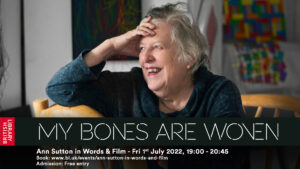Ten Things I Discovered When Making My Own Documentary
by Jane Mote, Editorial Consultant, The Whickers
Ok, I confess. Despite decades producing and executive producing factual programmes, making short audio and film documentaries as well as mentoring and training people to tell their stories across the world, I’d never directed a feature documentary. Until now.
It took a very special lady to lure me onto the long road to a feature doc – as well as the desire to find a project to support my videographer Josh Kershaw in starting his documentary journey. Ann Sutton, a weaver who changed her career completely at 78 to become a fine artist, was the subject of our film My Bones Are Woven and the inspiration for me to get well out of my comfort zone.
Now I’ve reached the end of this road I thought I’d let you in on some of the bumps I discovered along the way.
- Story is everything – The one thing I feel I did right was structure my story from the start. I resisted the conventionality of biography or an archive-driven story deciding instead to base the narrative in the present and look to the future for my 84-year old protagonist. The story is about reinvention, endless creativity, and defying age norms. I didn’t want to make something for a narrow art-only audience.
- Funding failure costs dearly – I found out quickly how little money there is for docs in the UK and the one obvious fund for us as first-timers -The Whickers – wasn’t open to me as I work there! So, I self-funded it squeezing filming into diary spaces that don’t exist and working with the tiniest of teams (mostly Josh and myself). Of course, we had a lot of freedom but we didn’t have much critical scrutiny. And it cost a lot!
- Transcribing as you go is a life-saver – the one expense I don’t regret was paying the receptionist in our shared office building to transcribe as went along. Not only did the transcripts help me script but Ruthanne was constantly noting great shots and scenes. Amazing for a newbie to documentary and better than an automated service.
- Leaving the editing until the end is a bad move – the biggest mistake of all. Because we were fitting this filming in around paid work the edit always went to the bottom of the to do list. By the time we started the world had changed. The pandemic was on, Ann had changed physically, and we then started discovering the shots we still needed and it was a mountainous task.
- Adversity is the mother of invention – when the pandemic started, we were able keep the story going even though we couldn’t get into Ann’s house using Zoom recordings and shots from the street with Ann toasting a neighbour on her doorstep. When we couldn’t afford to get on cruise ship with Ann to get to Shetland, she did some filming on her iPad which produced some fabulous shots.

- Staying close helps – if you are going to self-finance a film then make sure it’s convenient! Part of the reasoning for creating this film was that Ann’s house is minutes from our office. It meant we could respond quickly to sudden visitors or events and spend lots of time with her without always filming.
- Commission photos – we didn’t, and we didn’t photograph much as we were often both filming. Ideally you need a professional photographer on set at critical times. When you’re in a small crew it’s the last thing you think of, but sadly we have hardly any images to use for marketing.
- Keeping the core cast tight works – having too many characters can confuse the storyline. We cut a whole set piece because we didn’t feel our viewers couldn’t get their head around another protagonist. It felt brutal but it was the right thing to do.
- Luck comes to those who wait – we were so lucky to still be filming when Ann’s assistant decided to retire at 70 contrasting with Ann’s decision to start a new line of work in her 80s. It created an emotional peak in the film and helped to drive the final Act. Also (spoiler alert) the Tate made Ann’s dream come true by buying her art for their modern British collection.
- Don’t set yourselves tasks you can’t finish! – I needed a number 10 on this list just as I needed to draw a line on our documentary. So, we finished it and, even though I watch it and think of all the things we could have done, I still smile, laugh, and enjoy the story and time spent with Ann.
My Bones Are Woven is co-directed by Jane Mote and Joshua Kershaw. You can see it at the British Library as part of Ann Sutton in Words and Film, followed by a Q&A with Jane and Ann Coxon, Curator of International Art at Tate Modern.
Tickets are free but you need to book in advance. The date and booking link will be announced soon.


